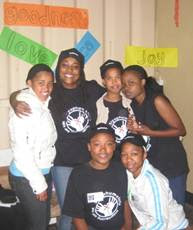Molo, sisi! This warm, isiXhosa “hello” greeted me when I arrived in Grahamstown, South Africa to begin my Fulbright experience. Like many other Fulbright grantees, I never could have imagined that my time in-country would be so enriching and life-changing. While South Africa is currently enjoying the global spotlight as the host of the 2010 World Cup, the country remains challenged by how to meet the needs of the nearly 6 million South Africans infected with HIV/AIDS.
My Fulbright project was part of my larger dissertation research that examines what happens in communities when HIV/AIDS treatment has been made available. During my year in Grahamstown, I was affiliated with the Raphael Centre, an NGO that offers testing and support services to those infected with and affected by HIV/AIDS. As a medical anthropologist, I worked closely with HIV-positive men and women to trace how they make decisions about their care and treatment, and more specifically, how they decide if and/or how they will take antiretroviral treatment. While the nature of my project was extremely sensitive and it was challenging to deal with the types of suffering I witnessed, I will forever be grateful to those who shared their life experiences with me.
 As a Fulbrighter, I took seriously my role as a cultural ambassador and fully embraced the tenant of “community engagement.” In addition to my research, I served on the Local AIDS Council, helped to organize World AIDS Day events, coordinated candlelight memorial services for HIV/AIDS victims, served as a foster mother for an orphaned infant, and – what I am most proud of—helped to create Camp Siyaphumelela. Siyaphumelela, isiXhosa for “We are coping/We are succeeding,” was designed to provide teenagers affected by HIV/AIDS with coping mechanisms to deal with the challenges they face in their everyday lives. Through the use of drama, dance, and music, camp participants are able to use various art media to express their emotions, and more importantly, create a trusting group of peers to support them long after their time at camp. With the tools gained during camp, the teens truly can say, “Siyaphumelela!”
As a Fulbrighter, I took seriously my role as a cultural ambassador and fully embraced the tenant of “community engagement.” In addition to my research, I served on the Local AIDS Council, helped to organize World AIDS Day events, coordinated candlelight memorial services for HIV/AIDS victims, served as a foster mother for an orphaned infant, and – what I am most proud of—helped to create Camp Siyaphumelela. Siyaphumelela, isiXhosa for “We are coping/We are succeeding,” was designed to provide teenagers affected by HIV/AIDS with coping mechanisms to deal with the challenges they face in their everyday lives. Through the use of drama, dance, and music, camp participants are able to use various art media to express their emotions, and more importantly, create a trusting group of peers to support them long after their time at camp. With the tools gained during camp, the teens truly can say, “Siyaphumelela!”
A few tips for applicants:
1. My primary advice to Fulbright applicants would be to START EARLY! The process will take several months and it is very important to start working on the pieces of your application, particularly securing an affiliation, as early as possible. Also, I definitely recommend that applicants get feedback from their Fulbright Program Advisers (FPAs), professors and/or colleagues before submitting their applications. If you are a currently enrolled student, you must apply through your campus’s FPA if available. At-large applicants (those not applying through an FPA) should seek out advice and feedback from colleagues, experts in the field, and former teachers or professors.
2. In the Statement of Grant Purpose, you really want to make clear why you have chosen to do your project and why that project is a great fit for the country you have selected. I think it is important to demonstrate that you have done your homework, understand your project’s specifics and any sensitivities involved.
3. Think of the Personal Statement as a “narrative CV.” What about you, your academic training and unique life experiences make you the best person to carry out your project? These are the things that I think should be highlighted in your application, as well as the ways in which you demonstrate a commitment to promoting and enhancing cultural exchange. I would encourage applicants to be creative, but also make sure that your personal statement is honest and leaves readers with a true sense of why your project is important and who you are.
Good luck!
Top photo: Chaunetta Jones, 2007-2008, South Africa, with rescued orphans Asanda and Luvo who benefit from the Raphael Centre’s outreach and support services.
Bottom photo: Chaunetta Jones, 2007-2008, South Africa (top row, second from left), with several Camp Siyaphumelela participants.


